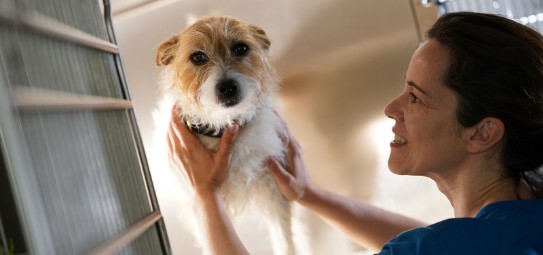
Cold weather dog walking tips for Greater London owners
October 7, 2022
With winter on the way and cold temperatures setting in across Greater London, it is important to know the limits of our faithful companions. The cold weather can pose serious risks for our pets, so the team at Alpha Veterinary Surgery have outlined some tips to keep your dog healthy, comfortable, and safe in the coming months.
Can you walk your dog in the snow?
Our vet nurses can confirm that you can walk your dog in the colder temperatures including in the snow. However, there are some precautions you should take beforehand.
- Consider dog sweaters, jackets, boots, or socks to place a barrier between them and the cold. This will keep them warmer and dryer – monitor your pet to avoid overheating.
- Mix up your dog’s walking routine to get them moving more – you can use objects on the walk such as lampposts to walk them around.
- Limit walks to 15 – 20 minutes to avoid the harsher effects of the cold.
- Look for cues such as whining, shivering, or hard skin – dogs can get frostbite too!
- Alternative forms of exercise should be encouraged such as indoor play if the weather is below freezing in Greater London.
- Even though some dogs are more tolerant of cold weather, you should not leave them outside for long periods of time with no warm retreat.
- Keep your dog’s toe hair clipped to prevent ice from getting stuck in their fur making it painful/difficult to walk.
- Walk your dog in the day when it is a bit warmer.
- Try and prevent them from grazing or licking ice and snow – these commonly contain toxic chemicals that can be fatal for your pet if ingested in certain amounts.
- Wipe your pet’s legs, paws, and stomach after a walk – this will:
- remove harmful chemicals before they have chance to lick them
- remove grit and rain/ice water that can irritate them
- help to minimise the risk of cracked paws
- warm your dog up a bit if you use warm water
How cold is too cold to walk your dog?
Our Teddington veterinary nurses advise that generally, any temperature below -4 degrees Celsius is dangerous for dogs of all shapes and sizes; above that you should be able to make a good judgement on which precautions to take.
It is important to remember all dogs are different – older, younger, small to medium breeds, and short-haired dogs are more at risk of developing frostbite or hypothermia on winter walks, so keep that in mind. If the temperature is uncomfortable for you outside (without six layers and a thick padded coat on), it is likely to be uncomfortable for your dog.
Remember though, you and your dog can also make great memories in the snow, so have fun!
If you have any extra tips, or just want to show off your dog in their new winter coat, go ahead and share them on our Facebook page.
A pre-winter health check can help to ensure your pet is fit and ready to take on the frosty season ahead. Call us on 0208 943 2303 to book one now.





